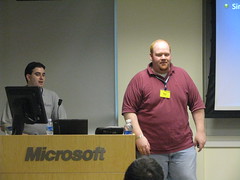 The most recent iteration of the SharePoint Saturday franchise, SharePoint Saturday DC, was held yesterday at the Microsoft Technology Center in Reston, Virginia. The day went very well, thanks to Dux Raymond Sy and his team of event coordinators, volunteers, and sponsors! Over 200 people were there and most of the sessions were packed and a few were standing room only!
The most recent iteration of the SharePoint Saturday franchise, SharePoint Saturday DC, was held yesterday at the Microsoft Technology Center in Reston, Virginia. The day went very well, thanks to Dux Raymond Sy and his team of event coordinators, volunteers, and sponsors! Over 200 people were there and most of the sessions were packed and a few were standing room only!There were a variety of session topics, including Dan Lewis's Social Computing talk, Tom Resing's Business Data Catalog presentation, and Jonathan Distler's overview of Arlington County, Virginia's SharePoint pilot. All-in-all, there were twenty-eight sessions plus an open "Ask the Expert" discussion in the lobby.
Dan Usher and I presented our talk SmartCard Authentication: Considerations, Options, and Pitfalls with SharePoint during the last session of the day, 4:45-5:45. Surprisingly, we still had the energy in us to have a lively discussion about security, SmartCards, and how they fit into a SharePoint implementation.
View the slides on SlideShare or download the PowerPoint file (PPT or PPTX) which includes the slides plus notes and resource links.
 View Online (slides only)
View Online (slides only)SlideShare
View PowerPoint (slides + notes/resources)
PowerPoint 2003 (PPT)
PowerPoint 2007 (PPTX)
A video of our talk may be made available at some point, and I'll post it here if it does.



